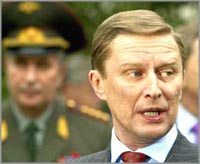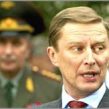
Russia Presses Military Modernization, Despite Financial Crisis
Publication: Eurasia Daily Monitor Volume: 6 Issue: 46
By:

On March 4 Russian Deputy Defense Minister for Finance and Economic Affairs Lyubov Kudelina outlined defense spending plans in light of the global financial crisis, expressing confidence that although there would be some cuts in the overall budget of the Ministry of Defense (MoD), this would not damage the reform and modernization of the armed forces. Kudelina said that as part of the ongoing effort to modernize the military 1,500 billion rubles ($42.1 billion) would be spent from 2009 through 2011 on acquisition and repair of armaments, research and development, and experimental design work. In 2009, according to Kudelina, the armed forces "should receive new aircraft of all types, helicopters, a significant amount of armored equipment and motor vehicles, surface-to-air missile systems, and ships and submarines" (Interfax, March 4).
The defense budget will be 1,439 billion rubles ($40.4 billion) in 2009, 1,509 billion ($42.4 billion) in 2010, and 1,615 billion ($45.3 billion) in 2011, with 36 per cent of these funds earmarked for weapons and equipment purchases or repairs and 32 per cent for military pay. The 2009 defense budget, however, has been cut by 8 per cent—not the widely reported figure of 15 per cent. Cuts will be made in construction and repairs, and other expenses will be reduced. Kudelina explained that this would not affect funding for military reforms or pay increases for servicemen. One notable feature of these plans is the avoidance of concentrating on individual supplies of arms and military equipment, preferring instead to provide a comprehensive rearmament of units and subunits. Moreover, Kudelina suggested that "optimizing" expenditures from state defense orders had freed a further 6 billion rubles that could be spent on weapons and equipment (Itar-Tass, March 4).
On March 2 Deputy Prime Minister Sergey Ivanov told a government commission on preventing bankruptcy in the defense industry that enterprises manufacturing non-military products had been badly hit by the financial crisis. Ivanov explained that the government was now implementing a whole range of anti-crisis measures designed to assist the defense industry. He said there were 1,400 strategic enterprises in the defense industrial complex on the commission’s register. These are located in 70 parts of Russia and employ approximately 1.5 million people; which are more than the total number of armed forces personnel. Direct public funding is considered the most efficient means of assistance, since this makes it possible for defense enterprises to avoid seeking bank loans at unknown rates of interest. In order to circumvent bankruptcy in the defense industry, the government has allocated 8 billion rubles ($223 million) for 2009 in support of "strategic enterprises." The commission decided during the meeting to allot subsidies to a number of shipbuilding yards to prevent them from going out of business (Interfax, March 2).
Ivanov claimed that there would be no reduction in Russia’s defense procurement plans, despite the problems within the defense industry. Government assistance would be given to enterprises throughout the defense industry, especially those manufacturing equipment for the Strategic Rocket Forces (RSVN), aviation plants, shipyards, and manufacturers of spacecraft and equipment for the ground forces, including the Iskander missile systems. The order of priorities is: the strategic nuclear forces, air force and navy, and precision weapons for the ground forces. Ivanov affirmed that:
With regard to the rest, some economizing is possible. More precisely, a pushing back of the time frame of the efforts. I am speaking here only about the technical re-equipment of the armed forces and other uniformed agencies, but not about social issues—housing and pay and allowances for the servicemen. The ultimate priority will always be guaranteeing the country’s security. This concept is composed not only of the nuclear forces but also of aviation, the surface fleet, [and] the Space Troops (Rossiyskaya Gazeta, February 26).
In short, despite the financial crisis, Russia will continue modernizing its armed forces and aims over the next three years to procure more than 70 strategic missiles, 30 for the Iskander operational-tactical system; 48 combat aircraft; more than 60 helicopters; six unmanned aerial vehicles; 14 ships; 300 tanks; and more than 2,000 vehicles. It will re-equip around 40 force groups and units. Ivanov stated confidently that:
The new national arms program will be adopted for the period from 2011 to 2020. I can give you its reference points even now. The strategic nuclear forces will have been re-equipped by 2020. Russia’s satellite group will have been replaced fully by more modern craft. A single battlefield information space will have been created. And, of course, there will be a transition to absolutely new, intellectual models of arms and military equipment (Rossiyskaya Gazeta, February 26).
When the military reform and modernization program was first announced by Defense Minister Anatoliy Serdyukov in October 2008, the time scale for transferring to a brigade-based, permanent-readiness structure and downsizing the General Staff by 200,000 officers envisaged achieving the bulk of those targets by 2012 and completing modernization by 2020. Now Ivanov is increasingly trying to quell speculation that the reform plans may falter because of the financial crisis. He admits, however, that the crisis makes "pushing back the time frame of the efforts" likely. As the government shores up the defense industry with its anti-crisis measures, the key priority for re-equipping Russia’s military is emerging clearly: there will be no backing away from updating Russia’s strategic nuclear capabilities. Achieving successful modernization of the conventional forces now appears to be slowing down, with the statements from leading government figures designed to allay economic fears within the struggling defense sector. The real fear is mass unemployment resulting from bankruptcy in key defense industries, which must be avoided at all costs.




